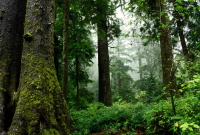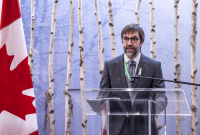Support strong Canadian climate journalism for 2025
Prime Minister Justin Trudeau’s opening speech at COP15 was interrupted by a group of Indigenous protesters playing drums and singing “Canada is on native land” and “climate leaders don’t build pipelines.”
In a roundtable discussion attended by Canada’s National Observer, Trudeau said there always needs to be room for protests of this nature. It is “part of the strength of our diversity as a country and our democratic processes,” he added.
Canada’s own environment minister has a history of participating in climate protests, one which involved him scaling the CN tower in 2001 (after which he was arrested).
“I have always believed in non-violent civil disobedience … when we were asked to host the COP, we said well, in Canada, these things are allowed,” Steven Guilbeault said at the roundtable.
There are high hopes this United Nations biodiversity conference will result in a strong global agreement to halt and reverse biodiversity loss and conserve 30 per cent of the world’s lands and waters by 2030 — the amount some scientists deem necessary to avoid dangerous biodiversity tipping points.
“We wanted to really make sure that (COP15) matched Canada's level of ambition for nature and biodiversity,” Trudeau told reporters at the roundtable. “We didn't want to just sort of slide by.”
The federal government is very vocal about its pledge to conserve 30 per cent of Canada’s land and sea by 2030, and Indigenous people — particularly women — are leading the charge, as they have for millennia. Guilbeault has been clear that there’s no path to 30 by 30 without Indigenous-led conservation in Canada.
Globally, Indigenous people protect 80 per cent of the world’s remaining biodiversity, according to a 2021 report by Territories of Life. Some Indigenous groups are concerned the draft text set to come out of COP15 — which will guide global action on biodiversity conservation — doesn’t acknowledge Indigenous land rights in biodiversity-rich areas. These fears are well-founded.
Around the world, Indigenous Peoples have been forcibly removed from their land under the guise of conservation, like the thousands of local people evicted to create Kruger National Park in South Africa.
In 19th-century Canada, the creation of national parks was used to dispossess Indigenous Peoples of their lands. Banff National Park and Vancouver’s Stanley Park both saw Indigenous people forcibly removed from their land.
After “decades and generations of colonial thinking,” the federal government is putting Indigenous communities “in the driver’s seat” and asking what they need, said Trudeau.
On Dec. 7, Canada announced $800 million in funding over seven years for four Indigenous-led conservation initiatives. This builds on a previously committed $340 million for Indigenous Protected and Conserved Areas (IPCAs) and the Indigenous Guardians program.
At the same time, the federal government’s plans to develop Canada’s critical minerals sector raise questions about the impacts of that activity on biodiversity. For example, in Ontario’s Ring of Fire, huge deposits of nickel, chromite and other minerals rest beneath carbon-rich peatlands that serve as critical habitat for caribou. Scientists say mining would unearth that planet-warming carbon and hurt biodiversity.
“Having a reliable source of these critical minerals, even if it's more expensive, because it's done properly, responsibly, is totally worth it,” said Trudeau. “And there is a market for that, because we don't want to be reliant on authoritarian states for our sources.”
The federal government is currently doing a regional impact assessment on the Ring of Fire, conducted with Indigenous communities, Environment Minister Steven Guilbeault said at the roundtable.
That process includes discussions about why certain areas may be off-limits, whether it's due to cultural significance or the land being critical caribou habitat.
“We sit down with them and we agree, as the prime minister was saying, if we are to do some development on your lands, how's it going to happen (and) under which conditions, which is a totally different way of doing it,” said Guilbeault.
It remains to be seen exactly how the federal government will balance its plans to ramp up the critical minerals sector with the need to protect biodiversity and respect Indigenous rights and title.
The chants of the protesters who interrupted Trudeau’s speech draw attention to battles being fought by Indigenous communities against pipelines and other development projects. Wet’suwet’en hereditary leadership and their allies are fighting the Coastal GasLink natural gas pipeline in B.C. The Athabasca Chipewyan First Nation is dealing with the fallout of toxic oilsands tailings ponds and fighting a plan to release treated tailings into the river upstream of the massive Mackenzie River watershed. While some Indigenous communities are able to utilize federal funding to steward their lands, others are grappling with the presence and legacies of industry.
Earlier this week, Guilbeault told Canada’s National Observer that New Zealand and Australia’s new government are allies in Canada’s push to defend Indigenous rights in negotiations.
“I was down in South America earlier this year, talking about these things with the governments of Colombia, Argentina, Chile,” he said in an interview. “They see what we're doing as being at the forefront of Indigenous-led conservation. And this is what we want to defend throughout the next two weeks of the negotiations and, obviously, beyond that.”
Natasha Bulowski / Local Journalism Initiative / Canada’s National Observer






Comments